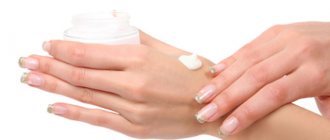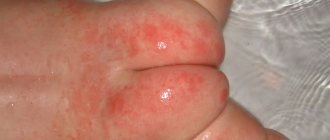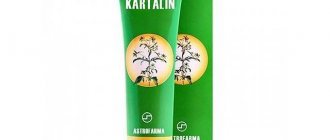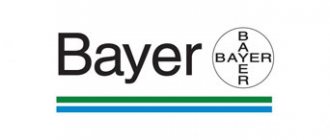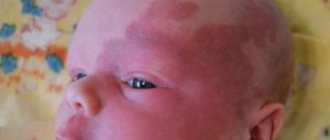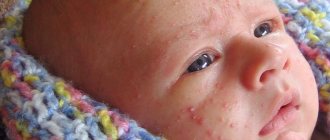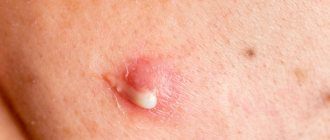Symptoms
Diaper rash is reddened areas of the skin, and hyperemic fragments of the dermis have clearly defined boundaries. They cause significant discomfort to the little ones: they itch and sting, so children become capricious and restless. Sometimes the inflamed areas may be slightly swollen. In rare cases, pimples and erosions occur on reddened areas. With prolonged absence of treatment and adequate care, the inflamed areas become covered with a purulent film .
Diaper rash most often occurs where air access to the dermis is difficult:
- on the buttocks;
- in the groin;
- in the cervical folds;
- behind the ears;
- armpits;
- in the folds on the baby’s arms and legs.
Why do diaper rash occur in infants?
The skin of a newborn is saturated with moisture and weakly resists the aggressive environment. The susceptibility of infant skin to infections and inflammation is very high. When exposed to unfavorable factors and insufficient care, diaper rash appears.
The causes of diaper rash can be of different types:
- Mechanical – friction, constant contact of the skin with moisture (wet diapers, full diaper), flow of milk or formula into the neck folds, hot, stuffy room, excessive sweating.
- Chemical – contact of the newborn’s body with feces, urine, allergenic creams or powders.
- Infectious – irritations caused by bacteria, fungi and their waste products.
It can be:
- non-compliance with the diet of a nursing mother (consumption of sweets, cow's milk, fresh fruits and vegetables, chocolate, nuts);
- violation of hygiene rules (rare bathing, untimely change of diapers);
- digestive problems (loose stools, diarrhea);
- poor-quality pipeline water (rusty, dirty water must be replaced with bottled water);
- allergies to soap, creams, wet wipes, powders, oil;
- reaction to diaper materials.
Having identified and eliminated the cause, the mother may notice an improvement, and sometimes even an absolute recovery of the baby.
Kinds
There are several types of diaper rash:
- Psoriasiform. They have a strictly defined shape, and the dermis flakes off, as with psoriasis. Such diaper rash appears suddenly on the skin of a child and progresses quite quickly.
- Herpetiformes. As the name suggests, such diaper rash in a baby is very similar to the manifestation of the herpes virus. Bubbles appear on the reddened skin, which, when ripe and burst, form ulcers. If such a rash appears in the baby, they will probably take a test to identify the virus in order to rule it out.
- Common. This type of diaper rash affects large areas of the skin, sometimes the inflammation spreads from the buttocks to the armpits.
- Granulomatous. Such diaper rashes very rarely appear and are diagnosed in infants. The cause of their occurrence is dysfunction of the immune system. The skin disease is characterized by dark-colored rashes with semicircular purple nodules in the center.
Symptoms and signs, differential diagnosis
Parents usually do not have any particular difficulties in identifying diaper rash. It is enough to remove the child’s clothes, diapers and diaper, and the clinical picture is obvious. And here it is important to understand in time what you are dealing with - impetigo or diaper dermatitis, seborrheic eczema or an allergic ring.
First of all, the mother should evaluate the nature of the rashes and compare them with infectious diseases. An infectious rash is almost always accompanied by a high fever . If a child is left without clothes for a couple of hours, the diaper rash will begin to decrease, fade, lighten, and the infection will spread further to other parts of the body. In the second case , you need to call a doctor at home and determine what kind of infectious disease has affected the baby and how to treat it .
The presence of pus and dry crusts always indicates the presence of a bacterial infection in the area of the inflammatory process. A whitish coating is a sign of a fungal infection.
In both cases, you need to consult a doctor and prescribe specific treatment (antibiotics, aniline dyes for bacterial damage and antifungal drugs for mycosis). In other cases, the mother can easily handle it herself.
Next, you should determine the degree of diaper rash. In modern pediatrics and dermatology, three degrees are distinguished.
The first one (also easy ). The skin is slightly inflamed, there are no wet areas, visually there are no damage, cracks or wounds on the skin. The child’s general condition has not changed – appetite and sleep are normal.
Second (middle) . The inflamed areas have a bright red color, there are areas of erosion, the integrity of the epidermis is damaged, there are small cracks, and small pustules may be present. The child behaves restlessly.
Third (heavy) . The affected area is large, there is swelling of inflamed areas of the skin, cracks and detachment of fragments of the epidermis, ulcers, and erosions. Signs of a bacterial or fungal infection may or may not be present. The likelihood of infection is very high. The child suffers from pain and burning, and the areas of inflammation are itchy. The baby’s health is disturbed, he cries, sleeps poorly or does not sleep, and refuses to eat. If the temperature rises, this is a sure sign of infection.
The first degree should not cause much concern. It is treated easily and quickly. In the second and third degrees, the child should be shown to a doctor.
Degrees
Each type of diaper rash occurs in several stages on the baby’s dermis. Depending on the extent of the damage, the doctor will determine the course of therapy. In mild forms, treatment may not be carried out, but rather limited to compliance with preventive measures and increased care for the baby’s skin. In severe forms, physical therapy and antibacterial drugs may be required.
- In a mild form, the newborn appears redness on the bottom or in the folds. Most often, diaper rash in a newborn occupies only one area of the skin that is most susceptible to negative effects.
- The average degree is characterized by pronounced redness of the skin, on which a rash already appears. As the rash matures, it forms ulcers.
- In severe cases, the depth of skin damage increases. Painful abrasions occur on the inflamed dermis, and the surface is covered with a purulent film due to bacterial damage.
Prevention measures
Follow simple rules, and your baby's skin will always be clean, without redness or rashes. Daily care requires time and effort, but the health of the baby is more important.
Ten rules for preventing diaper rash in babies:
- keep the skin clean, rinse thoroughly, then dry the folds;
- put on a diaper only with clean, dry skin;
- use antibacterial wipes less often: despite the advertising of “naturalness,” synthetic ingredients are still present;
- At home, put on your baby’s diaper less often: let the little body breathe. Do not wrap your baby up: overheating often causes excessive sweating, redness, and itching of tender areas. Perform air baths regularly, especially for the lower torso;
- choose a diaper that is breathable and does not irritate your skin. Buy products from well-known companies that are constantly introducing new developments;
- always keep diaper rash remedies in your medicine cabinet: talc, baby powder, Bepanten gel;
- Contact your pediatrician in a timely manner. If the rash does not go away after two to three days, see a doctor. Most likely, a fungal/bacterial infection was added to the inflammation;
- To prevent inflammatory processes, regularly add a herbal decoction to the bath. For 10 liters of warm water, 500 ml of healing liquid is enough;
- For washing, use special powder, safe baby soap. Buy baby skin care products from trusted manufacturers;
- if the cause is a food allergy, analyze the diet of the nursing mother or replace the formula with an “artificial” one. Visit an allergist: timely identification of a dangerous product will prevent complications. Sometimes a hypoallergenic diet lasts for years or a lifetime (if you are allergic to the protein gluten).
Below is a video about the treatment and prevention of diaper rash in babies:
Causes
The main cause of diaper rash in infants is insufficient or improper care.
- Skin inflammations can be triggered by an abundance of moisture: if the baby’s skin is not properly dried after water procedures, the baby sweats a lot due to the fact that he is overly wrapped up or every day you apply copious amounts of greasy cream to the dermis.
- Infrequent diaper changes also contribute to inflammation. Urine and feces cause burns to the skin, which causes redness to appear on the dermis.
- Insufficient ventilation of skin areas, coupled with moisture retention on them, causes diaper rash in newborns in the folds. Infants who are overweight are especially susceptible to such inflammation.
- Excessive use of soap in water treatments removes the protective layer from the surface of the skin and allows bacteria to penetrate into the upper layers of the dermis, causing severe painful lesions.
- Tight clothing or an incorrectly selected diaper can rub the baby's delicate skin. Injured areas not only cause pain to the baby, but also allow pathogenic bacteria to freely penetrate into the upper layers of the dermis and cause inflammatory processes there.
- Poor nutrition for a baby or a nursing mother can also contribute to the appearance of inflammation on the skin.
- Allergies to detergents, creams, powders, as well as poor-quality linen and clothing sometimes provoke inflammatory processes on the skin. Diaper rash on the bottom of a newborn also occurs due to the wrong brand of diapers - their insufficient absorption or a negative reaction to the elements included in the layers.
Treatment of diaper rash
You can fix the problem if you are sure that the cause of its occurrence is not pathological. In other cases, treatment should be prescribed by a qualified specialist. In severe cases of the inflammatory process, hospitalization may be required.
Medications
The choice and prescription of medications occurs only after determining the cause of diaper rash. This will allow you to determine the type of irritating source and protect your baby from negative effects.
Preparations in the form of ointments and gels are an effective remedy
Effective drugs are:
- Panthenol. Can be used as an ointment or spray. The main components are dexapanthenol, vitamin E and allantoin. The drug relieves redness, restores the skin, and acts as a pain reliever. Use it 5-6 times a day. On the second day a positive result is already noticeable;
- Bepanten. The cream or ointment can be applied an unlimited number of times. It is an analogue of Panthenol;
- Methyluracil. Contains lanolin and petroleum jelly. These substances provide the anti-inflammatory, regenerating and anabolic effect of the drug. For children under 3 years of age, apply the ointment 1 r. per day in a volume not exceeding 20 g. At older ages, problem areas are treated 2 times a day;
- Clotrimazole and nystatin ointment. The active ingredient of the drugs is an antifungal agent, but Clotrimazole has a wide spectrum of action, so it is prescribed more often. It has antifungal, antibacterial and antiseptic effects. The ointment is allowed for children from 2 years of age. Use it 2-3 times a day;
- Zinc ointment has a drying, disinfecting, regenerating and anti-inflammatory effect, and prevents the formation of purulent blisters. Apply it 5 times. in a day;
- Baneocin in powder form. Reduces the risk of diaper rash due to friction by forming a protective layer on the skin. Apply powder after bathing;
- in severe cases, Syntomycin liniment is used, which contains the antibiotic chloramphenicol and castor oil. The product is applied to the skin and a sterile bandage is applied, which must be changed after 48-72 hours. Children are allowed to use it after they reach the age of one month.
When applying ointments, you must follow the instructions for use and try to avoid getting the product on the mucous membrane to avoid an allergic reaction.
Folk remedies
Treatment of mild forms of diaper rash is carried out using products based on medicinal plants. Traditional medicine advises using baths with the addition of herbal infusions. They can be prepared from plants:
- chamomile;
- series;
- Birch buds;
- yarrow;
- calendula;
- sage.
The decoction is prepared by brewing 2 tbsp. l. herbs 1 l. boiling water Within 20-30 minutes. it must brew, then it is added to the bath. The child is seated in it for 10 minutes, and part of the body up to the waist should be immersed in water. After the procedure, the groin area is carefully wiped with a soft towel and treated with a hygiene product.
For treatment, you can use an infusion of oak bark, which is used to treat the affected area before bed. Buckwheat flour or corn starch is used as a powder. Aloe juice also has a healing effect, which should be used to wipe areas of inflammation.
It is recommended to keep the plant leaf in the refrigerator for three days before using it.
There are also recipes for preparing ointments:
- 300g food is mixed with 15g fish oil and 1g chloroform;
- dried calendula flowers are added to Vaseline;
- mix sour cream and propolis in equal parts.
Such products are applied to clean skin 3 times. per day, and after 10 minutes. washed off. The therapeutic effect is achieved in 2-4 weeks.
Before using folk remedies, you must consult a doctor about the advisability of their use. It is necessary to monitor the child’s condition and stop treatment if there is any deterioration.
How to treat diaper rash?
As already mentioned, the choice of how to treat diaper rash in newborns depends on the degree of damage to the dermis. Treatment of mild diaper rash in newborns is carried out using preventive measures:
- wash the baby’s skin more often with running water without soap after changing the diaper, then diaper rash on the bottom will not threaten him;
- change the diaper every three hours, such measures will preserve the baby’s skin and you will not later have to look for a way to get rid of diaper rash;
- after removing the diaper and performing water procedures, allow the baby to lie down with his bottom bare, taking air baths - this is the best remedy for diaper rash in newborns;
- Choose a low-alkaline product to wash your baby that will not wash off the protective layer and irritate the skin;
- Bathing with the addition of decoctions: oak bark, string, eucalyptus, birch buds soothes the skin of a baby well: traditional medicine has long considered the use of decoctions the best way to treat diaper rash.
Folk remedies
Traditional medicine has many remedies that help cure diaper rash in a child's groin. In particular, it is proposed to use vegetable oils, which are slightly heated in a water bath and then evenly applied to the baby’s skin. However, it is worth remembering that if the irritation is severe, the oil may worsen the situation.
A more common method is baths prepared using herbal infusions. The principle of their preparation is approximately the same: a herbal mixture is brewed in a small container, which is then poured into a bowl of warm water. Moreover, herbal baths help get rid of diaper rash not only for babies, but also for adults.
The basis for the baths is:
- pharmaceutical camomile;
- Birch buds;
- Oak bark;
- yarrow;
- wormwood;
- Salvia officinalis;
- calendula and other herbs with tanning and disinfecting properties.
They all have a pleasant smell that the baby will like, and they immediately reduce inflammation, reducing discomfort, and diaper rash goes away faster. However, some herbs, such as yarrow or wormwood, have a bitter taste; this is worth remembering when bathing your baby. Baths can also be used when the disease has passed, as a preventive measure.
Traditional recipes also recommend hand-made ointments, but before treating diaper rash with these ointments, you should seek the opinion of your doctor so as not to cause harm.
The first ointment is prepared on the basis of honey, take 300 grams of it, add 15 grams of fish oil and 1 gram of chloroform. The mixture is applied to the clean skin of a girl or boy, left for 10 minutes and then washed off.
The second recipe contains Vaseline with dried calendula flowers, which are also used after washing and then removed. The third recipe is prepared from propolis and sour cream, mixed in equal proportions.
The fourth is prepared on the basis of zinc ointment, to which two nystatin tablets and a few drops of vitamin A are added.
Creams and ointments
For better healing and soothing of inflamed skin, you can use special creams and ointments for diaper rash in newborns. Many infant skin care products are also designed to combat inflammation. Such creams (Bepanten, Panthenol) contain dexpanthenol, which accelerates the process of regeneration and renewal of the skin and are approved for newborns.
Diaper rash in a newborn will heal quickly if you approach the issue of treatment comprehensively. Follow the recommended care rules and apply diaper rash cream in newborns after air baths. It is important that they do not contain petroleum jelly - this substance will clog the pores and only intensify the course of inflammatory processes. As a rule, mild degrees of diaper rash in infants can be removed from the skin in 3-4 days. If the damage to the dermis intensifies and a rash, ulcers and cracks appear on it, contact your pediatrician for advice.
You can start treating diaper rash in newborns with special ointments (hormonal and antifungal) only after your pediatrician recommends it.
Diaper rash in newborns in the groin
Most often, diaper rash in the groin appears due to urine leakage. Since newborns often urinate in their diaper, the groin area is constantly in contact with urine. The acid contained in urine contributes to skin irritation and, as a result, the appearance of diaper rash. If feces are also released along with urine, then the situation becomes even worse, because feces cause the urine to secrete ammonia, and this greatly contributes to irritation .
Therefore, it is extremely important that the diaper absorbs liquid well. In addition, it is important to change dirty diapers as often as possible.
Recommendations
- Do not use very oily diaper rash creams to heal the skin - they will only increase inflammation;
- do not try to dry the baby’s weeping ulcers with iodine and brilliant green - using coloring compounds, you will not be able to control the course of inflammation;
- ventilate the room more often;
- Bathe your baby daily;
- wash the baby’s bottom and genitals after each diaper change and give him air baths;
- Make sure your baby is not too hot during walks and change his clothes in time so that he does not sweat;
- When inflammation occurs, do not only treat it, but also search for the root cause of its occurrence.
Remedies for diaper rash in children
Well, since in our time it is not fashionable to use traditional medicine, then I will offer you several medicines that can be purchased at pharmacies.
Sanosan . If you still can’t give up diapers, then this product is right for you. It has a drying and anti-inflammatory agent.
Bepanten . There is both cream and ointment. The main thing is that this drug contains provitamin B 5 and it copes well with diaper dermatitis.
Sudocrem . This remedy is well used not only for rashes and diaper rash, but also for burns, bedsores, and cuts.
Purelan . A Swiss drug that can be used from the first days of a baby’s life. Excellent for healing cracked nipples of a nursing mother and does not require rinsing.
Desitin . Copes well with inflammation and irritation, as well as diaper rash, dermatitis, burns and bedsores.
Zinc ointment . It is suitable exclusively for eliminating the symptoms of dermatitis and has an anti-inflammatory effect.
These medications should be used for redness, but if your baby has bleeding cracks or huge blisters with pimples, then I advise you to immediately contact your pediatrician. This way, the right treatment will be selected for you, and you will be able to avoid infectious diseases.
Types of diaper rash
Inflammations most often occur in the folds of the skin. The most common places for their appearance are the groin areas, neck folds, armpits, area behind the ears, popliteal and elbow folds. Diaper rash in a child is accompanied by unpleasant sensations. The baby may be bothered by itching and burning. Because of the pain, he begins to sleep worse and cry more often. There are three different degrees of diaper rash:
- 1st degree - minor redness without breaking the skin;
- 2nd degree - more pronounced redness with small cracks;
- The 3rd degree is pronounced redness, accompanied by purulent wounds and wet cracks.
In addition, there are several types of diaper rash; they require different treatment. Some redness appears due to external irritants. Others may be affected by symptoms such as food allergies. Let's look at how to recognize different types of diaper rash.
- Contact dermatitis. This type of skin inflammation is the most common. It manifests itself as redness in the groin area. It may be a reaction of the body to chemicals that are part of a disposable diaper.
- Intertrigo. It can occur as a result of skin folds rubbing against each other. You can often find this type of irritation in the groin area. Inflamed skin is very sensitive and urine getting into areas with wounds causes pain in the baby.
- Impetigo. This is an irritation that can be caused by staphylococcus and streptococcus bacteria. Symptoms of its appearance are small pustules in the groin or on the baby’s bottom. Most often, impetigo is a reaction to contact of the baby's sensitive skin with the diaper material.
- Food allergies. This type of diaper rash may appear during the introduction of complementary foods. Or due to changes in the mother's diet during breastfeeding. These rashes are located around the anus.
- Seborrheic eczema. This skin lesion can also be triggered by an allergic reaction of the body. Eczema is a fairly large redness with clear boundaries. It may feel greasy to the touch. Located in the lower abdomen or groin area.
- Candidiasis. This type of diaper rash manifests itself in the form of small red rashes with clear boundaries. They are located in groups and most often appear on the genitals.
